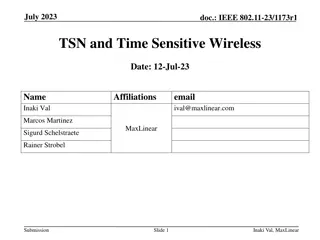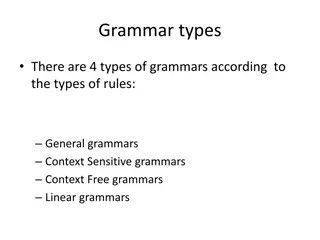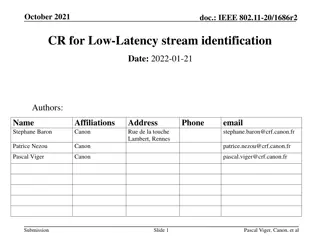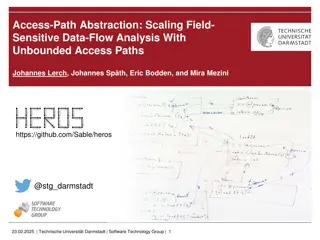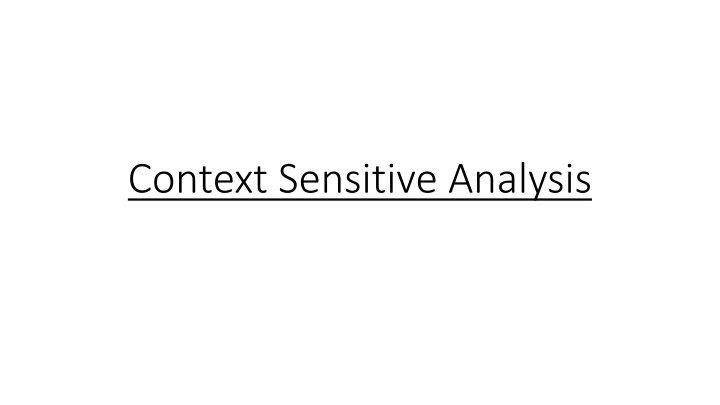
Context-Sensitive Analysis in Programming
Explore the concept of context-sensitive analysis in programming, delving into attribute grammars, syntax errors detection, code generation, and beyond syntax considerations. Learn about the importance of understanding the meaning of code and asking context-sensitive questions for proper code generation and error detection.
Download Presentation

Please find below an Image/Link to download the presentation.
The content on the website is provided AS IS for your information and personal use only. It may not be sold, licensed, or shared on other websites without obtaining consent from the author. If you encounter any issues during the download, it is possible that the publisher has removed the file from their server.
You are allowed to download the files provided on this website for personal or commercial use, subject to the condition that they are used lawfully. All files are the property of their respective owners.
The content on the website is provided AS IS for your information and personal use only. It may not be sold, licensed, or shared on other websites without obtaining consent from the author.
E N D
Presentation Transcript
Attribute Grammars After Lexical & Syntax analysis we have determined that the input program is a valid sentence in the source language. The outcome from syntax analysis is a parse tree: a graphical representation of how the start symbol of a grammar derives a string in the language. But, have we finished with analysis & detection of all possible errors? Now lectures: attribute grammars
What is wrong with the following? foo(a,b,c,d) int a,b,c,d; { } lala() {int f[3],g[0],h,i,j,k; char *p; foo(h,i, ab ,j,k); k=f*i+j; h=g[7]; printf( %s,%s ,p,q); p=10; } To generate code, we need to understand its meaning!
Beyond syntax: context sensitive questions To generate code, the compiler needs to answer questions such as: Is x a scalar, an array or a function? Is x declared? Are there names that are not declared? Declared but not used? Which declaration of x does each use reference? Is the expression x-2*y type-consistent? (type checking: the compiler needs to assign a type to each expression it calculates)
Beyond syntax: context sensitive questions In a[i,j,k], is a declared to have 3 dimensions? Who is responsible to allocate space for z? For how long its value needs to be preserved? How do we represent 15 in f=15? How many arguments does foo() take? Can p and q refer to the same memory location? These are beyond a context-free grammar!
Where We Are Program is lexically well-formed: Identifiers have valid names. Strings are properly terminated. No stray characters. Program is syntactically well-formed: Class declarations have the correct structure. Expressions are syntactically valid. Does this mean that the program is legal?
A Short Decaf Program class MyClass implements MyInterface { string myInteger; void doSomething() { int[] x = new string; x[5] = myInteger * y; } void doSomething() { } int fibonacci(int n) { return doSomething() + fibonacci(n 1); } }
A Short Decaf Program class MyClass implements MyInterface { string myInteger; I nt erf ace not declared void doSomething() { int[] x = new string; Can' t multiply st rings Wrong t ype x[5] = myInteger * y; } void doSomething() { Variable not declared Can' t rede fine f unct ions } int fibonacci(int n) { return doSomething() + fibonacci(n 1); } } Can' t add void No main f unct ion
Semantic Analysis Ensure that the program has a well-defined meaning. Verify properties of the program that aren't caught during the earlier phases: Variables are declared before they're used. Expressions have the right types. Arrays can only be instantiated with NewArray. Classes don't inherit from nonexistent base classes Once we finish semantic analysis, we know that the user's input program is legal.
Challenges in Semantic Analysis Reject the largest number of incorrect programs. Accept the largest number of correct programs.
Validity versus Correctness int main() { string x; if (false) { x = 137; } }
Validity versus Correctness int main() { string x; if (false) { x = 137; } } Safe; can 't happen
Validity versus Correctness int Fibonacci(int n) { if (n <= 1) return 0; return Fibonacci(n 1) + Fibonacci(n 2); } int main() { Print(Fibonacci(40)); }
Validity versus Correctness I ncorrect, int Fibonacci(int n) { if (n <= 1) return 0; should be ret urn n; return Fibonacci(n 1) + Fibonacci(n 2); } int main() { Print(Fibonacci(40)); }
Challenges in Semantic Analysis Reject the largest number of incorrect programs. Accept the largest number of correct programs. Do so quickly.
Challenges in Semantic Analysis Reject the largest number of incorrect programs. Accept the largest number of correct programs. Do so quickly.
Other Goals of Semantic Analysis Gather useful information about program for later phases: Determine what variables are meant by each identifier. Build an internal representation of inheritance hierarchies. Count how many variables are in scope at each point.
Limitations of CFGs Using CFGs: How would you prevent duplicate class definitions? How would you differentiate variables of one type from variables of another type? How would you ensure classes implement all interface methods?
Limitations of CFGs Using CFGs: How would you prevent duplicate class definitions? How would you differentiate variables of one type from variables of another type? How would you ensure classes implement all interface methods? For most programming languages, these are provably impossible. Use the pumping lemma for context-free languages, or Ogden's lemma.
Implementing Semantic Analysis Attribute Grammars Augment bison rules to do checking during parsing. Approach suggested in the Compilers book. Has its limitations; more on that later. Recursive AST Walk Construct the AST, then use virtual functions and recursion to explore the tree. The approach we'll take in this class.
Type Systems A value s type is the set of properties associated with it. The set of types in a programming language is called type system. Type checking refers to assigning/inferring types for expressions and checking that they are used in contexts that are legal. Components of a type system: Base or Built-in Types (e.g., numbers, characters, booleans) Rules to: construct new types; determine if two types are equivalent; infer the type of source language expressions.
Type Systems Type checking: (depends on the design of the language and the implementation) At compile-time: statically checked At run-time: dynamically checked If the language has a declare before use policy, then inference is not difficult. The real challenge is when no declarations are needed.
Context-sensitive questions The questions in previous slides are part of context-sensitive analysis: answers depend on values, not syntax. questions and answers involve non-local information. answers may involve computation.
Context-sensitive questions How can we answer these questions? Use formal methods: use context-sensitive grammars: many important questions would be difficult to encode in a Context-Sensitive Grammar and the set of rules would be too large to be manageable (e.g., the issue of declaration before use). attribute grammars. Use ad hoc techniques: Symbol tables and ad hoc, syntax-directed translation using attribute grammars. In scanning and parsing formalism won; here it is a different story!
Attribute Grammars Idea: annotate each grammar symbol with a set of values or attributes. associate a semantic rule with each production rule that defines the value of each attribute in terms of other attributes. Attribute Grammars (a formalisation by Knuth): A context-free grammar augmented with a set of (semantic) rules. Each symbol has a set of values (or attributes). The rules specify how to compute a value for each attribute.
Example (semantic rules to calculate the value of an expression) G E E E1+T | T T T1*F | F F integer T.val=T1.val F.val T.val=F.val F.val=integer.lexval print(E.val) E.val=E1.val+T.val E.val=T.val NB: we label identical terms uniquely! E val=1916 E T + val=12 val=1904 T T F * val=12 val=34 val=56 F F int val=12 val=34 val=56 int int val=12 val=34
Attributes Dependences between attributes: Synthesised attributes: derive their value from constants and children. Only synthesised attributes: S-attribute grammars (can be evaluated in one bottom-up pass; cf. with the example before). Inherited attributes: derive their value from parent, constants and siblings. Directly express context. Issue: semantic rules of one node of the parse tree define dependencies with semantic rules of other nodes. What about the evaluation order in more complex cases? (we ll come to this later )
Example (variable declarations) D T L T int | real L L1, id | id L.in=T.type T.type=integer T.type=real L1.in=L.in; id.type=L.in id.type=L.in In practice, we don t need to do all this with variable decla- rations! We can use a symbol table. There, all we need to do is to add a new entry into a symbol table. E.g.: addtype(id.type, L.in) D type=real T L type=real in=real L id real , in=real type=real What kind of attribute is type ? What about in ? id type=real 29
Another Example(signed binary numbers) Number Sign List List.pos=0; If Sign.neg then Number.val=-List.val Sign + Sign.neg=false | Sign.neg=true List List1 Bit List1.pos=List.pos+1; Bit.pos=List.pos; List.val= List1.val+Bit.val | Bit Bit.pos=List.pos; List.val=Bit.val Bit 0 Bit.val=0 | 1 Bit.val=2Bit.pos Sign neg:T val:5 List pos:1 val:4 Bit pos:1 val:0 val:4 Bit pos:2 val:4 else Number.val=List.val Num val:-5 List pos:0 Number and Sign have one attribute each. List and Bit have two attributes each. Val and neg are synthesised attributes; pos is an inherited attribute. What about an evaluation order? Knuth suggested a data- flow model of evaluation with independent attributes first. Implies a dependency graph! Bit pos:0 val:1 List pos:2 - 1 0 1 30
Attribute dependence graph If an attribute at one node depends on an attribute of another node then the former must be evaluated before the latter. Attribute Dependence Graph: Nodes represent attributes; edges represent the flow of values. Graph is specific to the parse tree (can be built alongside and its size is related to the size of the parse tree). Evaluation order: Parse tree methods: use a topological sort (any ordering of the nodes such that edges go only from the earlier nodes to the later nodes: sort the graph, find independent values, then walk along graph edges): cyclic graph fails! Rule-based methods: the order is statically predetermined. Oblivious methods: use a convenient approach independent of semantic rules. Problem: how to deal with cycles. Another issue: complex dependencies. 31
Binary Numbers example: dependency graph A topological order: 1. Sign.neg 2. List0.pos 3. List1.pos 4. List2.pos 5. Bit0.pos 6. Bit1.pos 7. Bit2.pos 8. Bit0.val 9. List2.val 10. Bit1.val 11. List1.val 12. Bit2.val 13. List0.val 14. Num.val Num val:-5 List0 pos:0 val:5 Sign neg:T List1 pos:1 val:4 Bit2 pos:0 val:1 - List2 pos:2 val:4 Bit1 pos:1 val:0 1 Bit0 pos:2 val:4 0 1 32
Using attribute grammars in practice Generic attribute grammars have seen limited practical use: Complex local context handling is easy. Non-local context-sensitive issues need a lot of supporting rules. Naturally, one tends to think about global tables all this takes time Still, there is some research and they have seen applications in structured editors, representation of structured documents, etc... (e.g, see attribute grammars and XML) 33
Using attribute grammars in practice In practice, a simplified idea is used: ad hoc syntax directed translation: S-attribute grammars: only synthesized attributes are used. Values flow in only one direction (from leaves to root). It provides an evaluation method that works well with bottom-up parsers (such as those described in previous lectures). L-attribute grammars: both synthesized and inherited attributes can be used, but there are certain rules that limit the use of inherited attributes. 34
Example (S-attribute grammar) 1. Goal Expr 2. Expr Expr + Term Using LR parsing the reductions for the string 19-8*2 make use of the rules (in this order): 8, 7, 4, 8, 7, 8, 5, 3, 1. The attributes of the left-hand side are easily computed in this order too! 3. | Expr Term 4. 5. Term Term * Factor | Term 6. | Term / Factor 1 Parse tree: The red arrow shows the flow of values, which is the order that rules (cf. number) are discovered! 7. 8. Factor number | Factor 3 9. | id Assume we specify for each symbol the attribute val to compute the value of an expression (semantic rules are omitted, but are obvious). 4 5 7 8 7 8 8
Finally Another example: (signed binary numbers again) Number Sign List Sign + | List List1 Bit | Bit Bit 0 | 1 Much of the (detailed) information in the parse tree is not needed for subsequent phases, so a condensed form (where non-terminal symbols are removed) is used: the abstract syntax tree. Number = Sign.neg*List.val Sign.neg=1 Sign.neg= 1 List.val=2*List1.val+Bit.val List.val=Bit.val Bit.val=0 Bit.val=1



